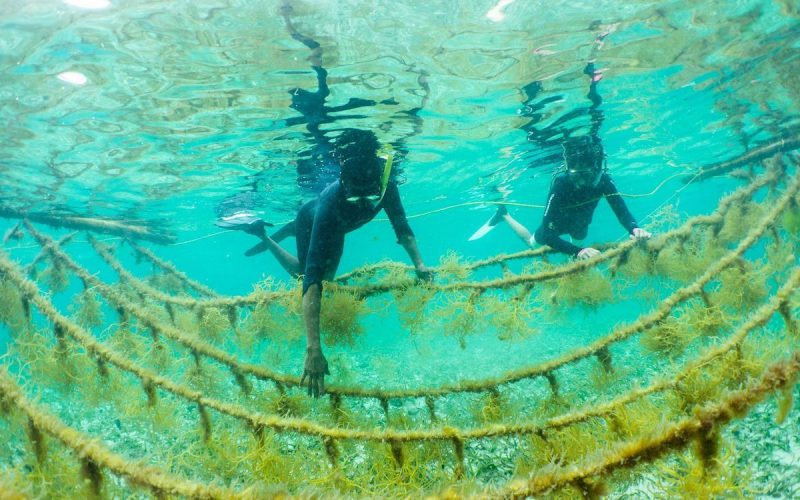Sea the future with restorative aquaculture
Waters off B.C. have strong potential for development of commercial shellfish and seaweed aquaculture that can also help salmon farmers
By Fabian Dawson
SeaWestNews
Shellfish and seaweed aquaculture in the waters off British Columbia provide numerous environmental and economic benefits to the region, says a new global study by scientists from the Nature Conservancy and the National Oceanic and Atmospheric Administration (NOAA).
The study, the first of its kind to examine the global potential for the concept of ‘restorative aquaculture’ found the commercial production of shellfish and seaweed will have a net-positive effect on the surrounding environment – filtering polluted waters and providing habitat for commercially-important seafood species.
“Enabling conditions suggest that development of a seaweed aquaculture sector in B.C. could provide numerous environmental and economic benefits to the region, including enhanced nutrient removal, habitat for commercially and recreationally important fish and invertebrate species, and novel employment opportunities,” said Dr. Seth Theuerkauf, aquaculture scientist at The Nature Conservancy and lead author of the study, which was published in the journal PLOS ONE.
This study follows another by Dr. Stephen Cross the former Industrial Research Chair for Sustainable Aquaculture at North Island College (NIC) in B.C. which showed that seaweed aquaculture can also play an important role for B.C.’s salmon farmers.
“The kelp-growing study involving over 40 fish farms showed good potential in growing seaweed within salmon farm tenures,” said Dr. Cross.
It found that excess nutrients from a fish farm could act as a fertiliser for kelp, supercharging the plant’s growth. In addition to kelp providing additional revenue, it will also absorb much of a farm’s waste, and act as a carbon sink.
There are more that 630 seaweed species in B.C.’s 20,000 km of coastline – the world’s most diverse – making it conducive for incredible production and market opportunity, said Dr. Cross.
At the moment, seaweed harvest in the province is mostly from the wild, totalling roughly 800 to 1,000 MT per year.
B.C.’s farmed oyster harvest totalled 7,700 tonnes in 2017 and accounted for more than one-third of the provincial shellfish harvest. Oyster sales in B.C. generated $29 million in wholesale value in 2017 and represented about half of the shellfish aquaculture industry’s value.
“There exists growing interest in seaweed aquaculture in BC, which is consistent with the identified high Restorative Aquaculture Opportunity Index (RAOI) score identified for development of seaweed aquaculture in this region in this study,” Dr. Seth Theuerkauf told SeaWestNews.com by email.
“Further, across the east and west coasts, Canada has a robust shellfish aquaculture sector,” he said.
“However, as we identified in our global-scale analysis, many high potential regions in the developed world, including parts of North America and Europe, shellfish and seaweed farmers in some locations encounter an inefficient or unclear permitting process, posing constraints to potential development of a restorative aquaculture industry.”
“Further, policy, regulatory, and permitting processes for shellfish/seaweed aquaculture often do not yet incorporate the potential positive environmental value farms can have into decision-making,” he said.
Key results from the global spatial analysis which reveals where marine aquaculture can benefit nature and people
- The opportunity for restorative aquaculture is truly global – there are marine ecoregions within all inhabited continents that have significant potential for shellfish and seaweed aquaculture to provide benefits to ecosystems and people.
- The top 10 highest opportunity regions for shellfish aquaculture development centered in Europe, Oceania, and North America, while the highest for seaweed aquaculture centered in Europe, Asia, Oceania, and South America.
- Europe’s North Sea marine ecoregion was consistently identified as the highest opportunity marine ecoregion for restorative shellfish and seaweed aquaculture development. The region’s coastal waters suffer some of the world’s most substantial nutrient pollution, widescale loss of shellfish reefs, and receives significant fishing pressure; commercial seaweed and shellfish farming could help to address some of these ecological challenges.
- Some identified high opportunity marine ecoregions, such as the East China Sea, already have robust shellfish and seaweed aquaculture industries. In such cases, the authors suggest reform or modifications in aquaculture practices could improve or optimize ecological benefits of farms.
- Other high opportunity regions, such as the Southern California Bight, have limited or virtually no existing bivalve and seaweed aquaculture operations and could environmentally and economically benefit from their development. And others, like Northeastern New Zealand, have an active shellfish aquaculture industry, but do not have an established seaweed aquaculture industry, which could help provide additional ecological function.
- Where funds to support traditional coastal ecosystem restoration efforts are limited—particularly within low or lower-middle income nations—development of shellfish and seaweed aquaculture sectors could present a significant opportunity to aid coastal ecosystem recovery efforts and economic development.
“Commercial shellfish and seaweed aquaculture present a rare opportunity to utilise commercial enterprise to directly benefit the health of our oceans and improve human wellbeing,” said Robert Jones, Global Lead for Aquaculture at The Nature Conservancy.

